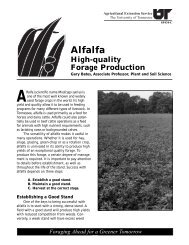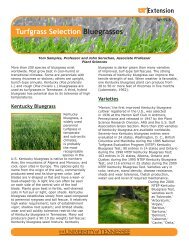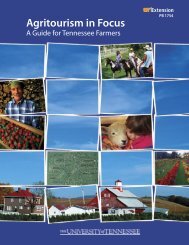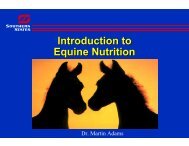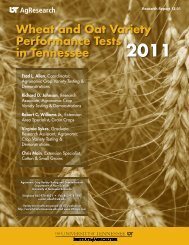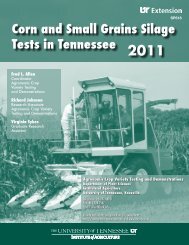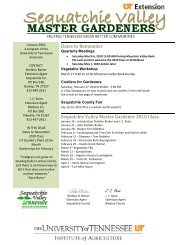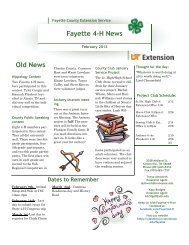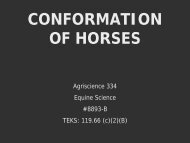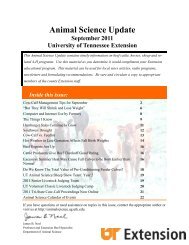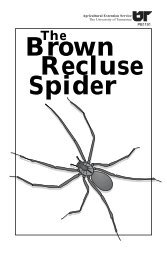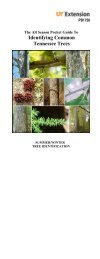Evergreen Trees for Screens and Hedges in the ... - UT Extension
Evergreen Trees for Screens and Hedges in the ... - UT Extension
Evergreen Trees for Screens and Hedges in the ... - UT Extension
Create successful ePaper yourself
Turn your PDF publications into a flip-book with our unique Google optimized e-Paper software.
SP 517<br />
<strong>Evergreen</strong> <strong>Trees</strong> <strong>for</strong> <strong>Screens</strong><br />
<strong>and</strong> <strong>Hedges</strong><br />
<strong>in</strong> <strong>the</strong> L<strong>and</strong>scape<br />
Donna C. Fare<br />
Assistant Professor<br />
Ornamental Horticulture<br />
& L<strong>and</strong>scape Design<br />
<strong>Screens</strong> <strong>and</strong> hedges are a popular way to create privacy<br />
or hide an undesirable view. They can be anyth<strong>in</strong>g from<br />
a section of a fence to <strong>in</strong>dividually designed panels, brick<br />
walls or a wall of green plant material. Plant<strong>in</strong>gs are usually<br />
a less expensive way to create privacy than a fence or<br />
wall. <strong>Screens</strong> or hedges also offer additional advantages to<br />
many l<strong>and</strong>scapes o<strong>the</strong>r than privacy. For example, <strong>the</strong>y can<br />
frame a terrace or provide a backdrop to a herbaceous garden<br />
or o<strong>the</strong>r garden features.<br />
<strong>Screens</strong> are loosely def<strong>in</strong>ed as evergreen, with dependable<br />
growth habits which mature at about shoulder height.<br />
<strong>Evergreen</strong> plants with low-branch<strong>in</strong>g habits <strong>and</strong> dense foliage<br />
are most effective <strong>for</strong> screen<strong>in</strong>g <strong>and</strong> provid<strong>in</strong>g <strong>the</strong> most<br />
privacy, especially <strong>in</strong> w<strong>in</strong>ter. In neighborhoods with small<br />
lots, <strong>in</strong>terplant<strong>in</strong>g with evergreens <strong>and</strong> deciduous plants<br />
offers a more <strong>in</strong>terest<strong>in</strong>g l<strong>and</strong>scape than a s<strong>in</strong>gle row of<br />
evergreen trees <strong>and</strong> shrubs.<br />
Wayne K. Clatterbuck<br />
Assistant Professor<br />
Forestry, Wildlife<br />
& Fisheries<br />
Choose plants carefully, pay<strong>in</strong>g particular attention to<br />
ease of ma<strong>in</strong>tenance <strong>and</strong> <strong>the</strong> desired effect. For a <strong>for</strong>mal<br />
look, plants must be clipped, which is time-consum<strong>in</strong>g <strong>and</strong><br />
an often-repeated task. An <strong>in</strong><strong>for</strong>mal, more natural appearance<br />
can be obta<strong>in</strong>ed with less ma<strong>in</strong>tenance us<strong>in</strong>g evergreen<br />
<strong>and</strong> deciduous plants. These plants can also provide o<strong>the</strong>r<br />
desirable l<strong>and</strong>scape qualities such as flower<strong>in</strong>g, showy fruit,<br />
fall leaf color <strong>and</strong> a variety of canopy <strong>for</strong>ms. Also, consider<br />
<strong>the</strong> mature size of <strong>the</strong> plants compared to <strong>the</strong> areas <strong>in</strong><br />
<strong>the</strong> l<strong>and</strong>scape. In an area where space is limited, like a side<br />
yard, use narrow or fastigiate (upright) tree <strong>for</strong>ms. These will<br />
provide <strong>the</strong> necessary height needed <strong>for</strong> screen<strong>in</strong>g, but will<br />
not overpower <strong>the</strong> width of <strong>the</strong> area.<br />
A mixture of plants such as small flower<strong>in</strong>g trees, evergreen<br />
trees <strong>and</strong> shrubs creates great eye appeal <strong>and</strong> will<br />
ensure aga<strong>in</strong>st a total loss if <strong>the</strong>re is a disease or <strong>in</strong>sect<br />
problem with one of <strong>the</strong> species. If fast-grow<strong>in</strong>g plants<br />
Leyl<strong>and</strong> Cypress is a fast-grow<strong>in</strong>g evergreen plant <strong>for</strong> a screen<br />
or hedge.<br />
Hollies, Dwarf Bur<strong>for</strong>d <strong>and</strong> Nellie R. Stevens, are effective <strong>for</strong><br />
screen<strong>in</strong>g with <strong>the</strong>ir low-branch<strong>in</strong>g habits <strong>and</strong> dense foliage.
(i.e. Lombardy poplar, white p<strong>in</strong>e) are used <strong>for</strong> an <strong>in</strong>stant<br />
screen, be aware that many are weak-wooded <strong>and</strong> shortlived.<br />
An <strong>in</strong>terplant<strong>in</strong>g of longer-lived species (i.e. holly,<br />
arborvitae) will fill <strong>in</strong> <strong>the</strong> vacant spots when <strong>the</strong> fast grow<strong>in</strong>g<br />
plants die or are removed.<br />
To reduce noise<br />
<strong>Screens</strong> <strong>and</strong> hedges also provide noise reduction, especially<br />
<strong>in</strong> urban areas where noise is easily refracted from<br />
hard surfaces like pavements or build<strong>in</strong>gs. Plants are better<br />
at absorb<strong>in</strong>g high-frequency sounds, which are most<br />
bo<strong>the</strong>rsome to human ears, than <strong>the</strong>y are at absorb<strong>in</strong>g lowfrequency<br />
sounds. Noise is measured <strong>in</strong> decibels (on a logarithm<br />
scale) <strong>and</strong> is best reduced when plants are placed <strong>in</strong><br />
two or three rows. For <strong>in</strong>stance, 2 feet of plant width can<br />
decrease <strong>the</strong> decibel level by four, while <strong>in</strong>creas<strong>in</strong>g <strong>the</strong> plant<br />
width with two or three plants can lower <strong>the</strong> noise level<br />
more than seven decibels. Some examples of noise levels:<br />
people talk<strong>in</strong>g measures about 30-60 decibels, large trucks<br />
average 60-80 decibels <strong>and</strong> jet airplanes create more than<br />
120 decibels.<br />
Low-grow<strong>in</strong>g plants, like shrubs, should be planted<br />
adjacent to <strong>the</strong> noise, with larger, taller plants immediately<br />
beh<strong>in</strong>d <strong>the</strong>m. A third row can be a selection of highly desirable<br />
shrubs that will face toward <strong>the</strong> liv<strong>in</strong>g area or garden.<br />
These plants should provide showy flowers, good fall color<br />
or attractive bark. <strong>Evergreen</strong> plants are <strong>the</strong> best choice,<br />
due to <strong>the</strong>ir dense branch<strong>in</strong>g habit <strong>and</strong> year-around noise<br />
protection.<br />
An excellent approach to noise reduction is to develop<br />
an ear<strong>the</strong>n berm about 3-4 feet high. The sides of <strong>the</strong> berm<br />
can slope about 5-20 percent, with an optimal slope of 10<br />
percent. A comb<strong>in</strong>ation of desired species can be planted<br />
on <strong>the</strong> top of <strong>the</strong> berm <strong>and</strong> along <strong>the</strong> sides. The comb<strong>in</strong>ation<br />
of <strong>the</strong> berm <strong>and</strong> plant material can reduce <strong>the</strong> noise<br />
level 6 to 15 decibels, which <strong>the</strong> human ear will perceive<br />
as one-third to one-half as loud.<br />
Plant<strong>in</strong>g on an earth berm can provide privacy as well as<br />
noise reduction.<br />
<strong>Evergreen</strong> <strong>Trees</strong> Ideal <strong>for</strong> Screen<strong>in</strong>g<br />
Botanical<br />
Name<br />
Common<br />
Name<br />
Height<br />
Spread<br />
Hard<strong>in</strong>ess<br />
<strong>in</strong><br />
Tennessee<br />
Comments<br />
Abies concolor<br />
White Fir,<br />
Concolor Fir<br />
30-50’<br />
15-30’<br />
All Tenn.<br />
One of <strong>the</strong> best firs <strong>for</strong> Tennessee due to heat <strong>and</strong> drought tolerance.<br />
This fir prefers well-dra<strong>in</strong>ed, s<strong>and</strong>y-loam soils; dislikes heavy<br />
clay soil. Full sun is preferable, but can tolerate light shade.<br />
Cryptomeria<br />
japonica<br />
Japanese<br />
Cryptomeria<br />
35-45’<br />
15-20’<br />
All Tenn.<br />
Rich green foliage; may have a bronzy hue <strong>in</strong> w<strong>in</strong>ter. Bark is beautiful<br />
reddish brown <strong>and</strong> peels off <strong>in</strong> long strips. ‘Yosh<strong>in</strong>o’ is <strong>the</strong> best<br />
known of all <strong>the</strong> cultivars.<br />
x Cupressocyparis<br />
Leyl<strong>and</strong>ii<br />
Leyl<strong>and</strong><br />
Cypress<br />
35-40’<br />
15-20’<br />
All Tenn.<br />
Fast grow<strong>in</strong>g. Excellent screen<strong>in</strong>g potential. Some fungal diseases<br />
have been reported. Many selections are available, <strong>in</strong>clud<strong>in</strong>g one<br />
with variegated foliage. Plant may be stressed <strong>in</strong> dry sites.<br />
Ilex aquifolium x<br />
I. cornuta<br />
‘Nellie R. Stevens’<br />
Nellie R. Stevens<br />
Holly<br />
15-25’<br />
10-15’<br />
Marg<strong>in</strong>al <strong>in</strong><br />
East Tenn.<br />
Sun or shade. Grows as a large shrub or small pyramidal tree. Lustrous<br />
green leaves <strong>and</strong> fast grow<strong>in</strong>g.<br />
Ilex latifolia<br />
Lusterleaf Holly<br />
15-20’<br />
15-20’<br />
Marg<strong>in</strong>al <strong>in</strong><br />
East Tenn.<br />
Large pyramidal tree <strong>and</strong> one of <strong>the</strong> best broad-leaved evergreens.<br />
Needs a well-dra<strong>in</strong>ed soil. ‘Mary Nell’ is a popular cultivar that sets<br />
great quantities of red berries.<br />
Ilex opaca<br />
American Holly<br />
20-30’<br />
15-20’<br />
All Tenn.<br />
Native. Sun or shade exposure, but prefers some shade. More than<br />
1000 cultivars are listed. Good dra<strong>in</strong>age is essential. Only <strong>the</strong> female<br />
produces berries, but a male plant is required <strong>for</strong> poll<strong>in</strong>ation. Free of<br />
most <strong>in</strong>sect pests <strong>and</strong> diseases.<br />
2
<strong>Evergreen</strong> <strong>Trees</strong> Ideal <strong>for</strong> Screen<strong>in</strong>g<br />
Botanical<br />
Name<br />
Common<br />
Name<br />
Height<br />
Spread<br />
Hard<strong>in</strong>ess<br />
<strong>in</strong><br />
Tennessee<br />
Comments<br />
Ilex x attenuata<br />
‘Fosteri 2’<br />
Foster Holly<br />
10-15’<br />
10-15’<br />
All Tenn.<br />
Sun or shade exposure. The branch<strong>in</strong>g habit is naturally conical <strong>and</strong><br />
dense, but responds to shear<strong>in</strong>g <strong>in</strong> a more <strong>for</strong>mal l<strong>and</strong>scape. ‘Foster<br />
#2’ is <strong>the</strong> female <strong>and</strong> produces an abundance of berries. ‘Foster<br />
#4’ is a male holly.<br />
Ilex x attenuata<br />
‘Savannah’<br />
Savannah Holly<br />
20-25’<br />
15-20’<br />
All Tenn.<br />
Pyramidal canopy <strong>for</strong>m, with light green foliage. Popular due to<br />
<strong>the</strong> abundance of large red fruits.<br />
Juniperus<br />
ch<strong>in</strong>ensis<br />
Ch<strong>in</strong>ese Juniper<br />
10-50’<br />
5-15’<br />
All Tenn.<br />
Many juniper selections are available with upright growth habitats.<br />
Foliage color may vary from green to blue-green <strong>and</strong> gray. Junipers<br />
per<strong>for</strong>m best <strong>in</strong> full sun <strong>and</strong> <strong>in</strong> well-dra<strong>in</strong>ed soil.<br />
Juniperus<br />
scopulorum<br />
Rocky Mounta<strong>in</strong><br />
Juniper<br />
30-40’<br />
3-15’<br />
All Tenn.<br />
A slow-grow<strong>in</strong>g, narrow pyramidal <strong>for</strong>m that often has several<br />
ma<strong>in</strong> stems. Withst<strong>and</strong>s drought conditions, <strong>and</strong> needs well-dra<strong>in</strong>ed<br />
soil. Several cultivars are available, <strong>and</strong> valued <strong>for</strong> <strong>the</strong>ir bluish cast<br />
of <strong>the</strong> foliage.<br />
Juniperus<br />
virg<strong>in</strong>iana<br />
Eastern Red<br />
Cedar<br />
20-40’<br />
10-20’<br />
All Tenn.<br />
Native. Tough tree, grows <strong>in</strong> a wide range of soil conditions. Likes<br />
full sun. An excellent specimen plant or used <strong>in</strong> a mass. Provides<br />
food <strong>and</strong> shelter <strong>for</strong> birds. Many cultivars offer a palette of foliage<br />
color, fruit <strong>and</strong> canopy <strong>for</strong>ms.<br />
Magnolia<br />
gr<strong>and</strong>iflora<br />
Sou<strong>the</strong>rn<br />
Magnolia<br />
25-45’<br />
10-50’<br />
Select most<br />
cold hardy<br />
selections.<br />
Native. Allow lower branches to grow to <strong>the</strong> ground. Large, fragrant<br />
white flowers <strong>in</strong> summer. Dwarf selections, ‘Little Gem’ <strong>and</strong><br />
‘Hasse’, are better suited <strong>for</strong> small l<strong>and</strong>scapes.<br />
Magnolia<br />
virg<strong>in</strong>iana<br />
Sweet Bay<br />
Magnolia<br />
10-20’<br />
10-20’<br />
All Tenn.<br />
Native. Can be grown as a s<strong>in</strong>gle trunk or multi-trunk tree. Showy<br />
white, lemon-scented flowers <strong>in</strong> summer. Foliage is semi-evergreen,<br />
with a sh<strong>in</strong>y, green surface <strong>and</strong> silvery beneath. Magnolia virg<strong>in</strong>iana<br />
var. australis holds its foliage through w<strong>in</strong>ter. The cultivar ‘Henry<br />
Hicks’ offers excellent sh<strong>in</strong>y evergreen foliage.<br />
P<strong>in</strong>us strobus<br />
Eastern White<br />
P<strong>in</strong>e<br />
50-80’<br />
20-40’<br />
All Tenn.<br />
One of <strong>the</strong> fastest grow<strong>in</strong>g p<strong>in</strong>es <strong>in</strong> <strong>the</strong> l<strong>and</strong>scape. There is great<br />
variation <strong>in</strong> p<strong>in</strong>es due to seed-produced plants. Best grown <strong>in</strong> full<br />
sun on fertile, moist, well-dra<strong>in</strong>ed soil.<br />
Prunus<br />
carol<strong>in</strong>iana<br />
Cherry Laurel<br />
25-30’<br />
20-35’<br />
Marg<strong>in</strong>al <strong>in</strong><br />
East Tenn.<br />
Native. Broad-spread<strong>in</strong>g canopy makes an ideal multi-trunk tree.<br />
Dense foliage, often pruned <strong>in</strong>to a <strong>for</strong>mal hedge. ‘Bright ‘N Tight’ is<br />
a compact <strong>for</strong>m.<br />
Thuja<br />
occidentalis<br />
Eastern<br />
Arborvitae<br />
35-40’<br />
15-25’<br />
All Tenn.<br />
Good as a specimen plant or massed <strong>in</strong> hedges. Choose superior<br />
cultivars, many of which have pyramidal or rounded canopy <strong>for</strong>ms.<br />
Thuja plicata<br />
Western Red<br />
Cedar<br />
(Arborvitae)<br />
35-40’<br />
15-25’<br />
All Tenn.<br />
Fast-grow<strong>in</strong>g, upright conifer which can be substituted <strong>for</strong> <strong>the</strong> overused<br />
Leyl<strong>and</strong> Cypress. Prefers moist, well-dra<strong>in</strong>ed soil <strong>in</strong> full sun or<br />
part shade. ‘Hogan’ is <strong>the</strong> most upright cultivar with good green<br />
w<strong>in</strong>ter foliage <strong>and</strong> ‘Giganteoides’ is a hybrid <strong>for</strong>m with <strong>in</strong>credible<br />
vigor.<br />
Tsuga<br />
canadensis<br />
Canadian<br />
Hemlock<br />
35-70’<br />
25-35’<br />
All Tenn.<br />
Makes a graceful hedge or specimen plant<strong>in</strong>g. Requires moist soil<br />
with good dra<strong>in</strong>age. May need some w<strong>in</strong>d <strong>and</strong> sun protection if<br />
used <strong>in</strong> West Tenn. Many selections <strong>in</strong>clude canopy <strong>for</strong>ms that are<br />
prostrate, globose (rounded) or weep<strong>in</strong>g.<br />
Tsuga<br />
carol<strong>in</strong><strong>in</strong>ana<br />
Carol<strong>in</strong>a<br />
Hemlock<br />
35-50’<br />
20-25’<br />
All Tenn.<br />
Noted to per<strong>for</strong>m better <strong>in</strong> urban conditions, but grows slower than<br />
Canadian Hemlock. Plants tend to be stiffly branched. Harder to<br />
f<strong>in</strong>d <strong>in</strong> <strong>the</strong> nursery trade.<br />
3
Spac<strong>in</strong>g requirements<br />
When plant<strong>in</strong>g a screen or hedge, allow adequate spac<strong>in</strong>g<br />
<strong>for</strong> <strong>the</strong> plants to thrive <strong>in</strong> a healthy environment <strong>and</strong><br />
provide <strong>the</strong> desired privacy. Listed below are some general<br />
guidel<strong>in</strong>es <strong>for</strong> spac<strong>in</strong>g plants <strong>in</strong> a hedge. Plac<strong>in</strong>g <strong>the</strong> plants<br />
<strong>in</strong> a triangular pattern <strong>in</strong>creases <strong>the</strong> area’s depth <strong>and</strong> has<br />
more appeal than plac<strong>in</strong>g <strong>the</strong> plants <strong>in</strong> a s<strong>in</strong>gle straight row.<br />
A screen may be necessary to hide utility mounts <strong>and</strong> distribution<br />
trans<strong>for</strong>mers <strong>in</strong> your neighborhood. Plant screen<strong>in</strong>g<br />
material at least 6 feet away from utility equipment on<br />
three sides <strong>and</strong> 12 feet away on <strong>the</strong> door or entrance side.<br />
When plants reach maturity, utility workers can still safely<br />
ma<strong>in</strong>ta<strong>in</strong> <strong>the</strong> equipment.<br />
Common Name<br />
Spac<strong>in</strong>g Between<br />
Plants<br />
Height after 5<br />
years, assum<strong>in</strong>g a<br />
3-gallon plant was<br />
<strong>in</strong>stalled<br />
Juniperus ch<strong>in</strong>ensis ‘Spartan’ a fast-grow<strong>in</strong>g columnar<br />
juniper ideal <strong>for</strong> use as a screen.<br />
Canadian Hemlock 5-7' 10-12'<br />
Eastern Red Cedar 5-7' 10-15'<br />
Foster Holly #2 4-6' 12-15'<br />
Leyl<strong>and</strong> Cypress 5-7' 10-15'<br />
Little Gem Magnolia 5-7' 8-10'<br />
Nellie R. Stevens<br />
Holly<br />
4-6'<br />
10-12'<br />
Savannah Holly 5-7' 10-15'<br />
References<br />
Dirr, Michael A. 1990. Manual of Woody L<strong>and</strong>scape Plants: Their<br />
identification, ornamental characteristics, culture, propagation <strong>and</strong><br />
uses. 4 th ed. Stipes Publish<strong>in</strong>g Company, Champaign, Ill.<br />
Harris, Charles W. <strong>and</strong> Nicholas T. D<strong>in</strong>es. 1991. Time-Saver St<strong>and</strong>ards<br />
<strong>for</strong> L<strong>and</strong>scape Architecture. McGraw-Hill Book Company,<br />
New York.<br />
Appreciation is expressed to Rob<strong>in</strong> Young <strong>for</strong> design of this publication.<br />
SP517-15M-7/98<br />
R12-4910-11-001-99<br />
Pr<strong>in</strong>t<strong>in</strong>g <strong>for</strong> this publication was funded by <strong>the</strong> USDA Forest Service through a grant with <strong>the</strong> Tennessee Department of Agriculture,<br />
Division of Forestry. The <strong>Trees</strong> <strong>for</strong> Tennessee L<strong>and</strong>scapes series is sponsored by <strong>the</strong> Tennessee Urban Forestry Council.




